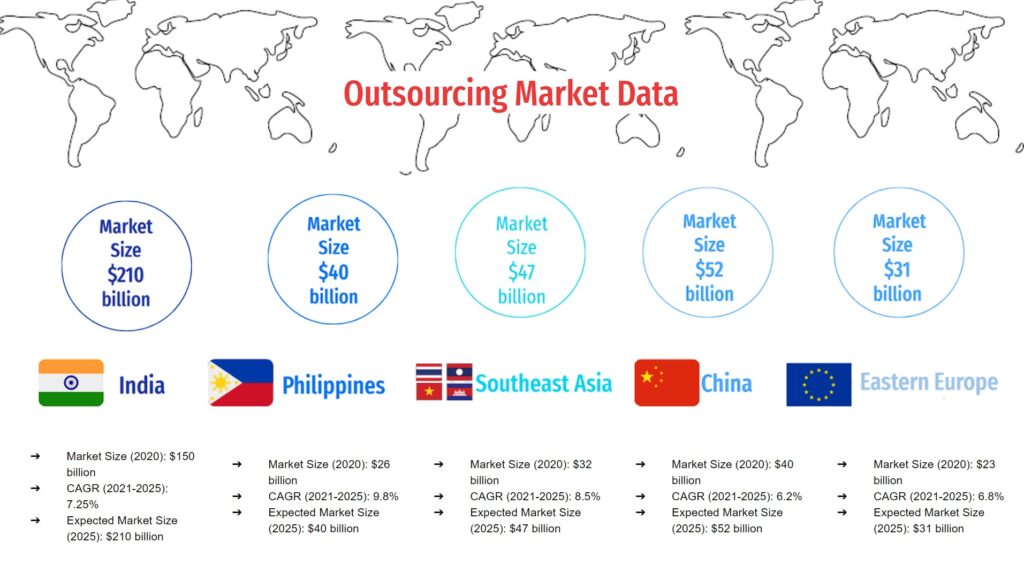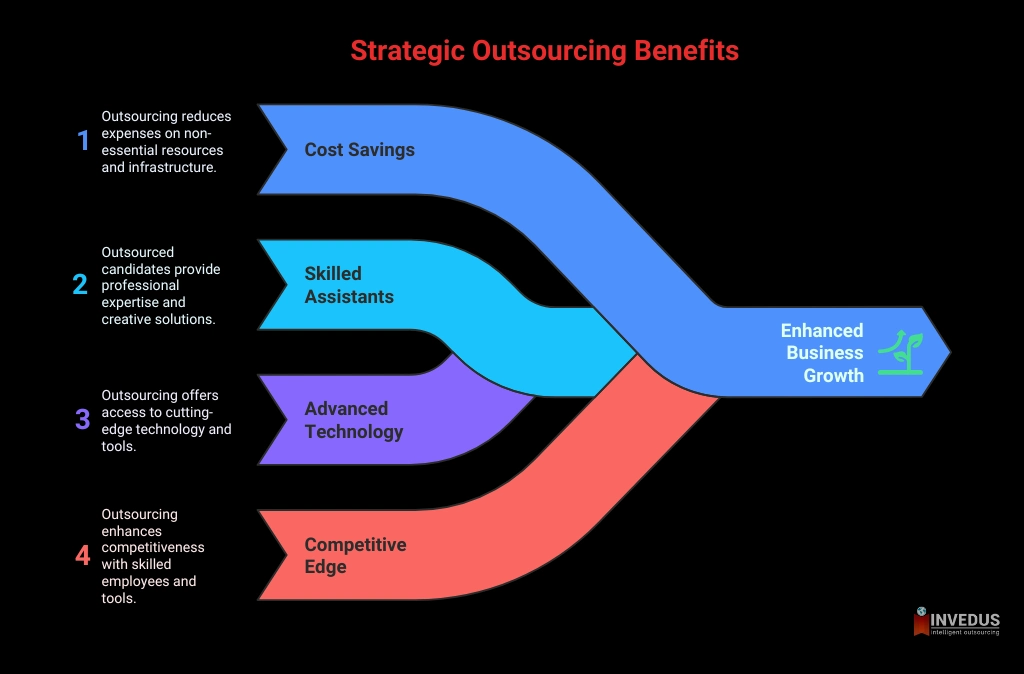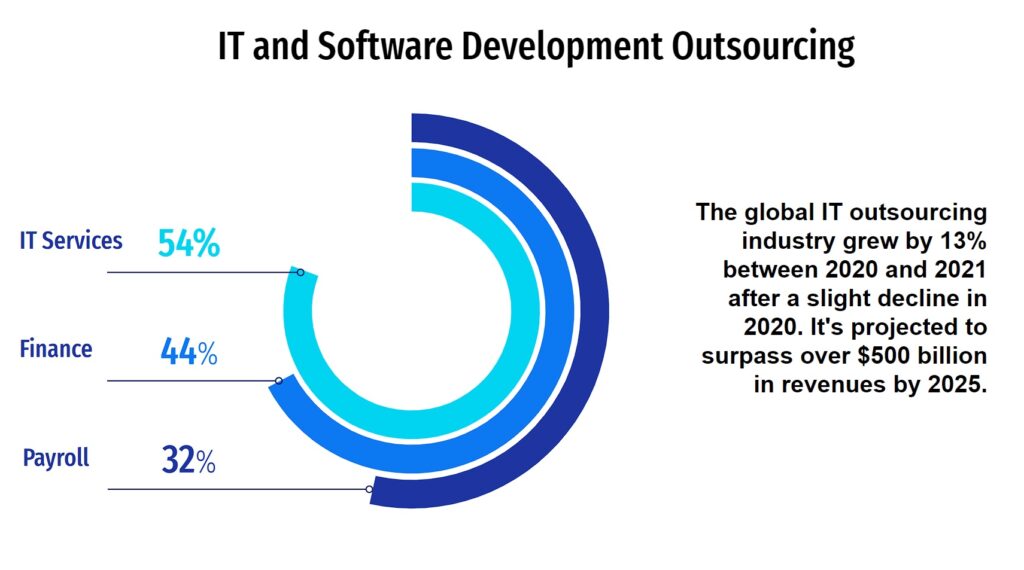
Outsourcing Statistics 2025: A Detailed Overview
Albert Einstein visualized when he said, “The only source of knowledge is experience.” Outsourcing has become a guiding light for businesses looking for experienced teams in this dynamic business world.
With the arrival of the Covid-19 pandemic, outsourcing adoption has further accelerated. This situation enabled organizations to embrace the benefits of global outsourcing. Global outsourcing allowed companies to adapt, utilizing the expertise of external parties.
In the realm of business strategies, outsourcing continues to thrive and shape the global landscape in 2025. This blog post will discuss recent outsourcing statistics on worldwide outsourcing and its role in today’s hectic marketplace. Read until the end to find new opportunities and challenges for businesses using this powerful strategic tool.
What Does the Global Outsourcing Landscape Look Like Today?
According to a report by Grand View Research on outsourcing, the global BPO industry can reach US $525 billion in valuation by 2030. It is expected to grow annually at a 9% compounded rate.
ISG also reports that the total value of outsourcing contracts worldwide is now around US $92.5 billion, and almost three-quarters of that comes from IT services. This means outsourcing is no longer just about saving money; it’s now a long-term way for both big and small companies to grow.
Today, outsourcing runs on digital tools.
With AI, secure cloud systems, and automation, both the outsourcing teams and companies are able to work together from any part of the world. With these changes, businesses are always connected, and projects move smoothly in different time zones.
Key Trends Defining the Global Market
| Trend | Key Insight | Source |
| Hiring Skilled Talent | About 75% of US employers struggle to find qualified professionals. Outsourcing helps businesses quickly access specialized skills they can’t find in-house. | ManpowerGroup, 2022 |
| Cloud-First Operations | Over 90% of organizations now use cloud computing in their outsourcing models, and Robotic Process Automation (RPA) is growing by nearly 40% each year, improving speed and efficiency. | Deloitte, 2024 |
| Cybersecurity and Compliance | Around 83% of IT leaders plan to outsource cybersecurity tasks, showing that data protection and compliance are now key priorities. | Syntax, 2024 |
| Remote and Hybrid Work | Nearly 35% of US professionals work remotely, making cross-border collaboration a normal part of modern outsourcing. | Pew Research Center, 2023 |
Leading Outsourcing Regions Worldwide
- India: The world’s outsourcing capital, offering expertise in IT, software development, and support services.
- Philippines: BPO contributes about 9% to the nation’s GDP (~US $27 billion) and employs over a million people.
- China: A global leader in service outsourcing with a market value near US $175 billion and 1 million new workers annually.
- Southeast Asia: Malaysia, Vietnam, and Thailand continue to expand in IT support and digital marketing.
- Eastern Europe: Poland, Romania, and Ukraine remain strong contenders in software engineering and back-office solutions.
- United Kingdom: Around 70% of UK B2B organizations outsource key business functions (YouGov 2024).
All of this shows that outsourcing has become a global way of working that connects people, skills, and technology across the world. As the market keeps growing, the focus is now moving from where outsourcing takes place to how it will help businesses grow in the future.
Also read: 10 Steps Approach to Successful Outsourcing Strategy
Major countries dominating the outsourcing market

How Will Global Outsourcing Evolve Between 2025 and 2030?
The global outsourcing market is already hitting the $500-billion mark.
The next few years are going to redefine how and why businesses outsource. For example, gone are the days when cost-saving was the top reason companies were outsourcing their tasks. Now they want smart collaboration, automation, and easily measurable outcomes.
Cloud and Cybersecurity Adoption
- To manage outsourced processes, more than 90% of businesses are switching to cloud solutions (Deloitte, 2024).
- At the same time, 83% of IT leaders plan to outsource cybersecurity tasks (Syntax, 2024). These numbers prove that adopting tech isn’t optional; it’s actually necessary to modernize your partnerships.
- Yet 68% of companies still name data security as their top concern, showing that trust and compliance remain just as critical as speed and cost.
Small-Business and Freelance Growth
Outsourcing isn’t just for enterprises anymore.
According to Clutch, 37% of small businesses now outsource at least one core function. Accounting, IT, marketing, and HR are the most common industries.
These HR outsourcing statistics prove that even smaller teams depend on external experts to stay compliant and flexible.
Meanwhile, freelancers now make up 38% of the U.S. workforce, contributing $1.3 trillion annually (Upwork / MBO Partners).
For many firms, the ideal setup blends in-house teams, virtual assistants, and managed offshore specialists, a hybrid workforce model that keeps operations agile.
Regional Shifts and Western Expansion
Countries like India, the Philippines, and China are still leaders in outsourcing, but now Western countries are increasing their use of it too.
In the U.K., about seven out of ten business-to-business companies now hire outside help for important work such as IT, accounting, or customer service. (YouGov, 2024).
American company outsourcing still drives the highest global demand, with offshoring companies in Asia and Eastern Europe managing thousands of outsourced jobs from America each year.
What’s changing is not the volume but the sophistication; firms are outsourcing analytics, cybersecurity, and creative work, not just support tasks.
The Bigger Picture
All these changes show that outsourcing is now about working smarter, using data, and building trust between teams. Companies that see outsourcing as a way to grow, rather than just a backup option, will lead the way in the coming years.
Benefits of Outsourcing

Did you note why companies are outsourcing their work to places like India? Sometimes it is better to change the old business plans to grow your business. It’s all about saving money and getting quality work done by an offshore partner. But what benefits can your offshore partner provide to your company? Let’s discuss it.
- It saves you from unnecessary expenses: It is one of the prime reasons major companies outsource their work. And there is nothing wrong with that. Every business looks forward to getting the job done at a low cost with the best skill. Outsourcing fits this criterion well. It helps businesses to spend less on non-essential resources and infrastructure.
- It gives you skilled assistants: In the present scenario, the companies prefer a candidate with relevant skills. Outsourced candidates are professional and have appropriate expertise in the field. Such candidates utilize their time developing creative and unique methods to complete the work.
- It gives you access to advanced technology: The best benefit one can get by outsourcing is access to top-notch technology. The outsourced candidates possess exceptional knowledge of new technology and tools. It can give your work a completely new overview.
- It gives you a competitive edge: If you want to stay ahead, looking for employees skilled in using trending software and tools is a good idea. And if you’re a small business owner or startup, you can boost your company’s reputation by hiring outside help for those tasks.
List of Outsourcing Statistics: Industry-Specific
We have compiled an extensive list of outsourcing statistics covering a wide array of industries and regions. Check it out.
IT and Software Development Outsourcing
The global IT outsourcing industry grew by 13% between 2020 and 2021 after a slight decline in 2020. It’s projected to surpass over $500 billion in revenues by 2025.
Report By: Statista Technology Market Outlook
According to this report, it is projected that the IT outsourcing industry will become an outstanding factor in revenue. When comparing revenue on a global scale, the United States is projected to generate the most, with a total of US$156.20 billion by 2023.

IT Services (54%), Finance (44%), and Payroll (32%) are the most frequently outsourced services.
Report By: Deloitte
This report shows an increasing trend toward utilizing remote models influenced by the lessons learned from COVID-19. Models like Shared Services Centers (SSCs) and Global Business Services (GBS) are adjusting well to the changing geopolitical landscape.
The IT & Telecommunications segment dominated the revenue share of the BPO industry.
Report By: Grand View Research
This report states that the global market for business process outsourcing was worth USD 261.9 billion in 2022. Experts forecast a growth rate of 9.4% between 2023 and 2030.
IT and business services organizations spent $7.5 billion in the EMEA region during Q1 of 2022. This involves Europe and the Middle East.
Report By: Computer Weekly
Tech research and advisory company ISG reported that spending on IT and BPO contracts over $5m increased by 21%. It reached a record-breaking $7bn in the region compared to last year.
Customer Service and Call Center Outsourcing
The BPO industry in Japan will generate $38 billion by 2025.
Report By: Statista
According to this report, the BPO market in Japan generated around 4.56 trillion Japanese yen in 2021. It is projected that sales of BPO services in Japan will exceed 5 trillion yen by 2026.
89% of customers make repeat purchases after having a positive consumer experience.
Report By: Salesforce
This survey portrays a view of a dynamic world facing various challenges, including economic, health and climate crises. The barrier between personal and professional lives is becoming blurred. As a result, businesses should adapt to meet evolving customer demands.
Companies providing exceptional customer service can attract consumers willing to spend 17% more.
Report By: American Express
This report states that 81% of Americans are satisfied with the service businesses provide, up from 67% in 2014. 40% have noticed companies making more efforts to improve their services.
27% of small businesses rely on outsourcing for their customer service needs. Around 27% of small enterprises outsource customer service.
Report By: Clutch
According to this report, 90% of small businesses plan to outsource business functions in 2022. This is an increase from 80% in 2021.
Manufacturing and Production Outsourcing
More than 6,600 outsourcing firms are currently operating in China.
Report By: China Business Review
This report shows how the outsourcing industry of China has made incredible progress. It is now on the verge of becoming a dominant force in the worldwide market.
A staggering 70% to 80% of all manufactured products are believed to be outsourced.
Report By: Orient
According to manufacturing outsourcing statistics, companies prefer China for low labor costs. Some also outsource to the United States.
China holds the position of the leading manufacturing powerhouse worldwide.
Report by: Statista
According to the US statistics division, China’s manufacturing output in 2019 amounted to 28.7% of the world’s total. It beats the United States by more than 10 points.
Mobile App Development Outsourcing
Cloud computing is seen as a crucial factor in the outsourcing strategies of 90% of companies.
Report By: Springer Link
Many businesses aim to focus on cloud technology. Cloud computing has been gaining popularity since the outbreak of COVID-19. Most companies acknowledge adopting cloud computing approaches. But data security issues and other associated risks impede the switch.
Software development is the most common outsourced IT function
Report By: Statista
According to a 2017 survey, IT leaders worldwide outsource software development. Almost 64% of respondents indicated so.
The IT outsourcing industry in India is predicted to experience a 7.25% CAGR growth by 2025, reaching a value of INR 8,830 billion ($121,335,149.20).
Report By: Business Wire
India holds the top position for IT outsourcing globally, owing to various reasons. A projection is being made that India will have the highest number of software developers by 2023/2024. This will surpass the United States in this domain.
Software outsourcing in Asia is set to show an annual growth rate (CAGR 2023-2027) of 9.16%.
Report By: Statista
The market volume for IT outsourcing can reach US$136.10bn by 2027, with an annual growth rate in revenue. The projected spend per employee in this segment is US$46.26 in 2023. The US can also generate the highest revenue compared to other countries, with US$156.20bn in 2023.
Finance and Accounting Outsourcing
60% of contracts for outsourcing finance and accounting services are not expected to get renewed.
Report by: Gartner
This report states that many finance and accounting organizations will not renew 60% of their BPO contracts by 2025. This is due to outdated pricing models that fail to promote digitization and process improvement.
Business process outsourcing accounts for 9% of the Philippines’ GDP.
Report By: Matchboard
The Philippines outsourcing industry is worth $27 million. It employs one million Filipinos, contributing 10% to the country’s economy. Due to a literacy rate of 97% and a low small wage of $300 per month for graduates, the Philippines is a favored location for outsourcing.
Accounting and IT services are the most popular outsourced processes for small businesses.
Report by: Clutch
It is common for small businesses to outsource certain functions, with accounting and IT services being the most outsourced at 37%. Digital marketing follows behind at 34%, while development, human resources, and customer support are also outsourced at 28%, 24%, and 24%.
Human Resources Outsourcing
Human resource outsourcing market share will rise by USD 10.90 billion between 2021 and 2026, with a CAGR of 4.87%.
Report By: Technavio
The global HR outsourcing market will be dominated by a certain continent, with an estimated 56% of its growth between 2022 and 2026 coming from there. Technavio predicts that the market will experience a gradual increase of $10.90 billion from 2021 to 2026.
75% of HR professionals feel their department is working beyond capacity and stretched too thin.
Report By: SHRM
It’s not unexpected that HR departments get overwhelmed nowadays. According to the State of the Workplace Report 2021-2022, almost 75% of HR professionals feel their workload is too much and needs to thin. Additionally, 42% believe they need more dedicated personnel to achieve organizational goals.
Companies can save 27.2% by outsourcing their HR services.
Report By: NAPEO
By hiring professional employer organizations (PEOs), companies can reduce expenses by outsourcing HR functions such as hiring, recruiting, ensuring compliance, and handling unemployment claims. According to a study by NAPEO, the average cost savings from hiring a PEO can result in a 27.2% return on investment.
Legal Process Outsourcing
The legal process outsourcing (LPO) market has experienced significant growth in recent years, with projections indicating continued expansion. According to a report by Grand View Research, the global LPO market was valued at approximately USD 13.67 billion in 2022 and is expected to grow at a compound annual growth rate (CAGR) of 31.4% from 2023 to 2030.
Report By: Grand View Research
These figures suggest that the market could reach approximately USD 38.13 billion by 2027, aligning with the projected robust growth rate. The increasing demand for cost-effective legal solutions and the adoption of digital technologies across the legal sector are key factors driving this expansion.
The India Factor
Did you know that India has been a player in the IT industry since the 80s? It wasn’t until the early 90s that outsourcing to India took off though. Back then, global airlines started outsourcing their back-office tasks to India.
Soon after, IT companies followed suit. Some of the first big companies in the Indian outsourcing market were Texas Instruments, American Express, Swissair, and British Airways. They all set up shop in India and started providing IT software and tech services. In the present scenario, the industry has developed and is a major player in the world of IT.
Nowadays, a lot of companies need to outsource to get things done right. They’re always on the lookout for a great place to do it. In this respect, one country stands out among the rest—India. It’s a great country to get quality work done at a good price.
Have you heard of India’s outsourcing growth? It’s pretty huge. Metropolitan cities like Mumbai, Bangalore, and Hyderabad rank among the best destinations for outsourcing companies. India is known for being a top spot for IT outsourcing, and there are plenty of reasons why!
- India delivers unmatched quality services at affordable costs with the fastest turnaround time. In this way the work gets finished at night while the client is offline.
- Exceptional Customer support is the primary reason why 80% of European and US countries outsource from India.
- India’s IT and software development sector is fifth largest in the world. This makes it a favorable destination for IT outsourcing.
- India is home to over 1.2 billion people, and 3.1 million graduates enter the job market every year.
- India provides candidates at affordable pricing.
NASSCOM is a top tech industry in India. In their survey, they state reasons why many companies outsource to India. This is because of its large talent pool, cost-effective salaries, and help from the National Association of Software Service Companies.
Outsourcing in the Digital Age
In this day and age, businesses need to keep up with the times and go digital if they want to survive. But it’s not about getting the latest tech and gadgets – sometimes outsourcing can be a big help too. It’s a vital part of digital transformation and can make your life a lot easier.
By outsourcing certain tasks, you can save money and free up time to focus on other important stuff. Plus, you’ll get to work with other experts and learn new things. So if you’re looking to boost productivity and profits, it’s definitely worth considering!
The Rise of Digital Outsourcing Models
You must have noticed how many companies that outsource are using cloud computing and Robotic Process Automation. The global cloud computing market is going to be worth over $1 trillion by 2026. Similarly, the Robotic Process Automation (RPA) market was valued at USD 2.94 billion in 2023 and is projected to grow at a CAGR of 39.9% from 2023 to 2030. And it makes sense, right?
These digital outsourcing models are super flexible, cost-efficient, and secure. Plus, RPA can automate all those boring tasks, so people can focus on more important stuff. It’s no wonder so many organizations are jumping on board with this tech trend.
Conclusion
Outsourcing is becoming more and more popular in the business world, and the numbers back it up. Digital outsourcing, like cloud computing and RPA, is especially on the rise. And it’s no wonder why – these approaches are cost-efficient, scalable, and help businesses run smoothly. Outsourced companies can give businesses a leg up over their competition and help them grow. It boosts productivity, innovation, and strategic focus.
As the world keeps changing, outsourcing remains a powerful tool for businesses to keep up with technology, get specialized help, and optimize their operations. We hope through this blog post you get a clear picture of outsourcing stats.
Are you looking for a reliable and professional offshore partner? Consider Invedus for outstanding services. Here we have a team of dedicated virtual assistants who can help you in achieving exceptional results. Connect with us to discuss your project in detail.
